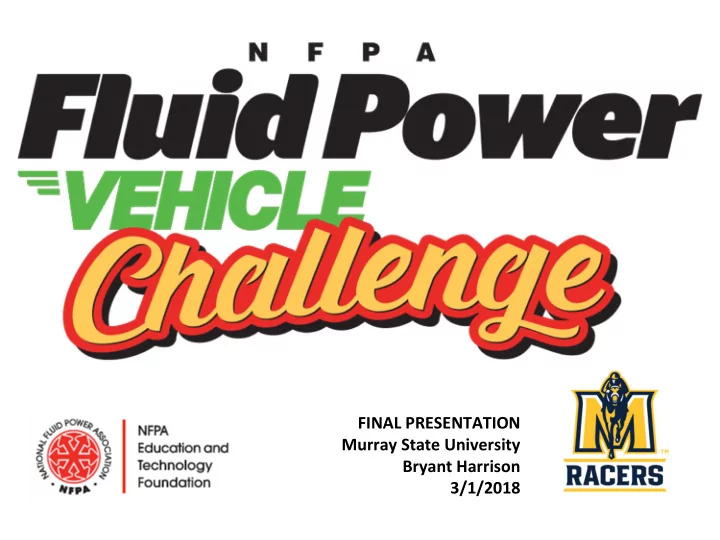

FINAL PRESENTATION Murray State University Bryant Harrison 3/1/2018
Joe Irby • Electromechanical Engineering Technology • Graduating May 2018 • Electrical/Hydraulics/Calculations/Manufacturing
Kevin Mackie • Electromechanical Engineering Technology • Graduating December 2019 • Hydraulics/Calculations/Manufacturing
Grant McCuiston • Manufacturing Engineering Technology • Graduating December 2018 • Research/Testing/Cost Analysis
Cooper Lindberg • Electromechanical Engineering Technology • Graduating May 2019 • Steering/Wiring Systems
Evan Kellems • Electromechanical Engineering Technology • Graduating May 2019 • Reservoir Design Process and Construction
Kyle LeBarron • Electromechanical Engineering Technology • Graduating May 2018 • Reservoir Design Process and Construction
Joey Caldwell • Electromechanical Engineering Technology • Graduating December 2018 • Manufacturing
Problem Statement We need to create a vehicle that can store hydraulic energy and release on demand while also being able to incorporate regenerative braking.
Midway PROTOTYPE
Midway Problems • Low mechanical advantage for pumping the accumulator to max pressure • Reservoir needed to be vented • Streamline connections • Hydraulic motor created drag while coasting • Electric clutch too complex to solve in time
Design Process Component Hydraulic Analysis Testing Schematic Problem Design Design Vehicle Compete Statement Analysis Drawings Assembly 3D Component CAD/SOLID Vehicle Testing WORKS Adjustments Drawings
Vehicle Changes Since Midway • Changed from leg mounted pumps to arm mounted hand pumps • Steering with our legs • Back pumps • New reservoir
Vehicle Design and Construction • Topics: – Steering System – Reservoir – Hydraulics – Accumulators – Hand Pumps
Steering System • Removed pumps • Steering with legs • Improved turn radius
First Reservoir • Completely 3D printed • Inside lined with resin • Holds 2.25 gallons • Hard to seal
Final Reservoir • Constructed out of PVC piping • Holds 3.67 gallons of fluid • Used a two tank system
Hydraulics Propulsion: Blue Regen: Red
Hand Pumps • Why hand pumps? • What are the advantages? • Placement of the pumps
Accumulators • 3 Accumulators – Main Accumulator • 2.5-gallon • Carbon fiber • Weighs 14-lbs • Varying precharge – Extra Accumulators • Two .251-gallon • Weighs 10-lbs per accumulator • Fixed precharge
Vehicle Testing Total Fluid (3 Accumulators) Accumulator Precharge Gallons Max PSI Divide by Nitrogen Fluid per Type (PSI) (U.S.) Max PSI Level accumulator (Gallons) Large 900x 2.5 3,000 2,250/3,000 .75 2.5-.75= Accumulator 1.75 Small 1,625x .251 3,000 407.875/ .136 .251-.136= Accumulator 3,000 .115 Small 1,550x .251 3,000 3389.50/ .130 .251-.130= Accumulator 3,000 . 121 Total Fluid Amount: 1.75+.115+.121= 2.21 Gallons
Vehicle Testing Total Volume (2 Reservoirs) Formula: PI(r^2)*Height = Volume in^3 PI(3^2)*15” = 424 in^3 per reservoir 424 in^3*2 = 848 in^3 Convert the inches cubed into U.S. gallons.. 848 in^3 * .0043290 = 3.67 gallons
Efficiency and Lap Race Test Run Results Determined our course lap was 0.13 mile. Kyle’s Efficiency Race Results: *Without pumping during test run* Run 1: Precharge(900 PSI) = 4.25 laps in 3 mins 15 secs Run 2: Precharge(525 PSI) = 4.5 laps in 3 minutes Joe’s Efficiency Race Results: *Without pumping during test run* Run 1: Precharge(900 PSI)= 3.75 laps in 3 mins 30 secs Run 2: Precharge(525 PSI)= 4.25 laps in 3 mins 22 secs
Sprint Race Test Run Results Determined our course was 0.09 mile. Drivers held button during race. Kyle’s Sprint Race Results: 165 lbs ➔ Run 1: Precharge(1,000 PSI) = 11.1 seconds Joe’s Sprint Race Results: 310 lbs ➔ Run 1: Precharge(1,000 PSI) = 11.5 seconds Joey’s Sprint Race Results: 240 lbs ➔ Run 1: Precharge(1,000 PSI) = 10.4 seconds
Cost Analysis • HP 16-21 Hand Pump (x4) : $200 . 00 = $600.00 • MicroMax Bladder Accumulator: $900.00 • Parker VOAC Bent-Axis Hydraulic Motor: $2,223.00 • 2-Way, Spool Directional Control Valve: $150.00 • Parker Hydraulic Accumulator (x2): $240.30 = $480.60 • 50 ft of Parker Hydraulic Hose and Fittings: $284.00 • Bike Frame: $250.00 • 3D Printer Material: $20.00 • Misc. Expenses: $200.00 Total Material Cost: $5,107.60
Lessons Learned 1. More component testing should be completed before assembly process. 1. Incorporate electric clutch for free spinning without spinning the motor. 1. For more mechanical advantage we need longer lever arms to allow for easier pumping. 1. The center of mass is located too far back. 1. 3D printed material can lead to potential issues such as leaking.
Final Vehicle
Q&A Questions?
Recommend
More recommend